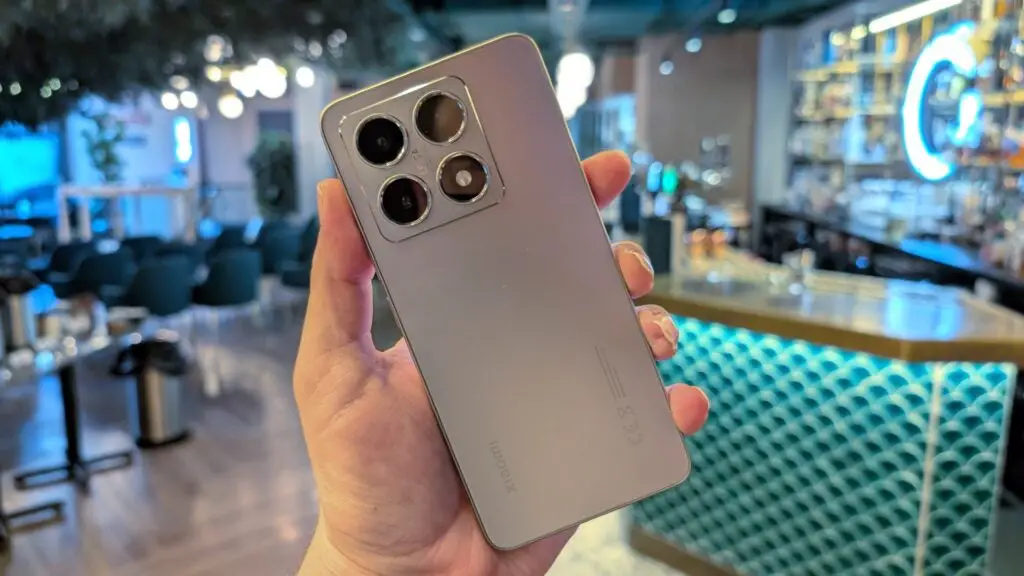First Impressions
The Xiaomi 14T looks to offer a whole host of premium smartphone tech without the associated price tag. While it’s not quite as capable as the more expensive Xiaomi 14T Pro, I’d argue that the benefits are pretty minimal, with key features – like display tech, cameras and battery life – consistent among the two.
Key Features
- Leica co-developed camera setupThe Xiaomi 14T not only has a triple camera setup that includes a telephoto camera, rare for the mid-range market, but it was created with photography experts Leica.
- Premium screen experienceThe 6.67-inch AMOLED screen is packed with premium tech like a 1.5K resolution, 144Hz refresh rate and peak brightness of 4000 nits. The uniform slimline bezels also help boost that screen experience.
- Plenty of processing powerThe Xiaomi 14T sports the premium MediaTek Dimensity 8300 Ultra that should outpace much of the mid-range competition.
Introduction
Xiaomi has the mid-range market in its sights with the release of the Xiaomi 14T, offering a plethora of features usually reserved for flagship smartphones.
That not only includes uniform slimline bezels around the whole phone, but a premium display experience with a 1.5K resolution and 144Hz refresh rate, a trio of Leica-branded lenses – including a telephoto not often seen on mid-rangers – and what looks to be plenty of processing power from the MediaTek Dimensity 8300 Ultra.
While I’m not yet ready to deliver my final thoughts on the mid-ranger, I spent a bit of time with the Xiaomi 14T at a pre-launch event, and here are my initial impressions.
Design and Screen
- Industrial design with flat edges and rounded corners
- 6.67-inch AMOLED screen with high-end tech
- Slim bezels around all four edges of the screen
Both the Xiaomi 14T and its more expensive sibling, the Xiaomi 14T Pro, offer a new design that Xiaomi’s calling a “Titan design”. I’m not quite sure what makes it particularly Titan-like aside from the Titan Grey colour finish, but I’d be lying if I said I didn’t like the look of this year’s mid-rangers.
Both phones have adopted the ever-popular industrial look, complete with flat edges and, in the case of the regular 14T, a completely flat frosted glass back. The 14T Pro has a slightly curved rear that should fit a little more snugly into the palm of the hand, but I had no complaints when handling the regular 14T at the hands-on event.
That double glass offering has an aluminium alloy frame sandwiched between, and the company claims that it’s 116% stronger than the aluminium used in last year’s Xiaomi 13T range. That should help protect it from damage when being dropped, but that’s not something I could test at the event – without getting into a lot of trouble with Xiaomi reps, anyway.
Continue the tour of the strengthened aluminium alloy frame and you’ll come across a new textured power button. It’s something we’ve seen from plenty of manufacturers before, essentially giving you a tactile way to tell the difference between the volume and power buttons – especially important when both are nestled next to one another on the right-hand side of the device.
It’s also pretty durable for a mid-ranger, offering full IP68 dust and water resistance that’s only available on a select few options in the category, and Xiaomi claims it’s actually safe down to a boosted 2m of water for up to 30 minutes.
Where the Xiaomi 14T really shines is in the screen department; not only is the OLED screen packed with tech usually exclusive to high-end phones, like a 1.5K resolution, 144Hz refresh rate, 12-bit colour depth and a whopping 4000nits peak brightness that delivered a really nice viewing experience during my hands-on time, but the bezels are pretty thin for a mid-ranger – and along all four edges too.
That might sound like a given, but look closely at most smartphones and you’ll notice that it’s not – especially in the mid-range market where there’s one ‘fat’ side, usually at the bottom of the screen. The uniform slimline bezels around the entire screen make the phone look and feel way more expensive than it actually is.
There is a really subtle curvature at the edges of the screen, though I wouldn’t describe this as a curved screen. It’s more rounded so that side swipes and similar gestures feel nice and smooth, instead of catching on the gap between the frame and the glass as with most truly flat screens.
When it comes to colour options, you’ve got quite a few to choose from; aside from the aforementioned Titan Gray colour, you can get it in Titan Blue and Titan Black and, if the glass isn’t to your liking, you can always go for the Lemon Green finish complete with a 100% recycled PU leather rear.
Cameras
- Triple camera setup on the rear
- Co-developed by Leica
- Capable of 8K video recording
Cameras are a huge focus when it comes to the 14T range as a whole, with both the regular Xiaomi 14T and 14T Pro sharing the same Leica-partnered camera setup comprised of a 50MP main, 50MP 2.6x telephoto and 12MP ultrawide.
That might not sound that impressive, but the 50MP camera is powered by the 1/1.31-inch Light Fusion 900 sensor, borrowed from the flagship Xiaomi 14. Xiaomi claims that this boosts light intake by 32% when combined with the wide f/1.6 aperture, and that should improve low-light photography in particular but that’s something I’ll be putting to the test for the full review.
As such, I didn’t get much of a chance to experiment with the Xiaomi 14T’s camera hardware at the hands-on event, though the few sample snaps I did take seemed to offer impressive quality and plenty of light, especially for a mid-ranger.
It’s also worth noting that Xiaomi is leaning heavily on AI camera processing this year, with four LLMs to focus on four areas of camera processing – FusionLM, ToneLM, ColorLM and PortraitLM. There’s also 8K video recording, along with 10-bit LOG recording and Master Mode to provide more pro-level controls for more advanced users.
Performance and Software
- MediaTek Dimensity 8300 Ultra
- Packed with AI features
- Fast 67W wired charging
The Xiaomi 14T and 14T Pro are both fairly evenly matched in terms of design, screen and camera tech, but that’s not the case with performance.
The 14T Pro gets treated to the top-end Dimensity 9300+ chipset while the regular 14T gets the generation-old – but still pretty powerful – Dimensity 8300 Ultra, paired with either 12- or 16GB of RAM and either 256- or 512GB of storage.
It’s pretty hard to gauge general performance at these hands-on events, especially without the ability to run any quick benchmark tests, but it felt pretty speedy during my time with the device, no doubt aided by the slick 144Hz refresh rate.
That’s paired with a fairly standard 5000mAh battery and fast 67W wired charging that should deliver a full charge in 45 minutes according to Xiaomi, though it does trail behind the 120W wired and 50W wireless on offer from its more premium sibling. That phone will get a full charge in just 19 minutes if Xiaomi’s claims are on the mark.
The smartphone boasts Xiaomi’s new HyperOS based on Android 14 out of the box, though it’s very much business as usual if you’ve used any Xiaomi devices in the past – it just feels a little slicker.
The key addition for the Xiaomi 14T is, of course, generative AI capabilities. Xiaomi has packed in quite a few new features here too, including live translation not only just for face-to-face conversations but phone calls and even online meetings with support for third-party apps like Zoom and Google Meet. That translated text can also be summarised, as can any audio recording on the phone.
There’s also a new AI Video Editor that can stitch together videos and photos for sharing on social media, and you can use natural language text prompts to adjust the look and feel, pace and more, all without actually having to edit it yourself. That’s in addition to existing AI features like AI Expansions, Portrait Mode and more present on the Xiaomi 14.
It’ll also feature Google’s Circle to Search tech, though it’s coming via an OTA update on 6 October and, as such, not something I was able to test during the hands-on.
Latest deals
Early Thoughts
The Xiaomi 14T looks to offer a whole host of premium smartphone tech without the associated price tag. While it’s not quite as capable as the more expensive Xiaomi 14T Pro, I’d argue that the benefits are pretty minimal, with key features – like display tech, cameras and battery life – consistent among the two.
It’ll certainly be interesting to see how the Xiaomi 14T performs in our suite of benchmark tests. Check back for our full review very soon.
You might like…
Full specs
UK RRP
USA RRP
Manufacturer
Screen Size
Storage Capacity
Rear Camera
Front Camera
Video Recording
IP rating
Battery
Fast Charging
Size (Dimensions)
Weight
Operating System
Release Date
Resolution
HDR
Refresh Rate
Ports
Chipset
RAM
Colours
Stated Power
Xiaomi 14T
£549
Unavailable
Xiaomi
6.67 inches
256GB, 512GB
50MP + 50MP + 12MP
32MP
Yes
IP68
5000 mAh
Yes
75.1 x 7.8 x 160.5 MM
193 G
Android 14 (HyperOS)
2024
1220 x 2712
Yes
144 Hz
USB-C
MediaTek Dimensity 8300 Ultra
12GB, 16GB
Titan Gray, Titan Blue, Titan Black, Lemon Green
67 W
A ‘hands on review’ is our first impression of a product only – it is not a full test and verdict. Our writer must have spent some time with the product to describe an early sense of what it’s like to use. We call these ‘hands on reviews’ to make them visible in search. However these are always unscored and don’t give recommendations. Read more about our reviews policy.











